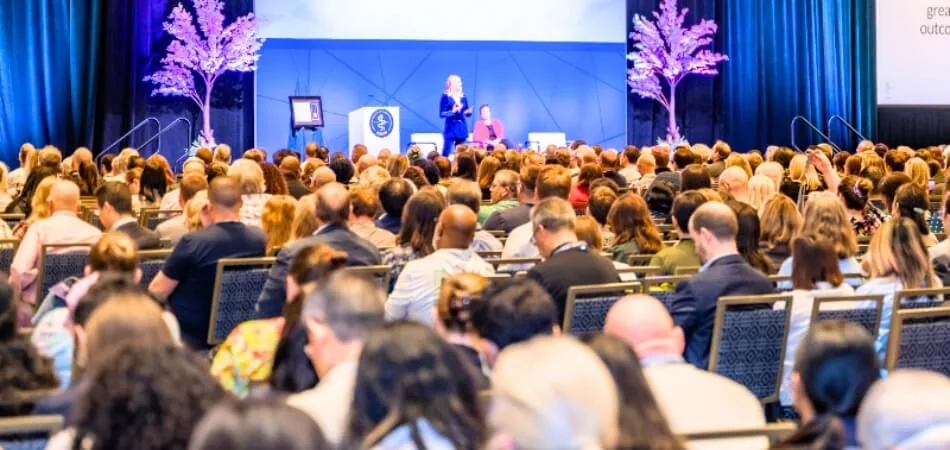Meetings and conferences are two pillars of collaborative exchange in any field. There is a slight confusion between these two, and a common question often arises: What type of communication is a meeting and conference?
Firstly, meetings have specific goals and encourage participants to talk to each other which is a direct form of communication. On the other hand, conferences, larger in scale, gather key players to discuss and disseminate information on a broader subject known as a dynamic form of communication.
Both serve as platforms for knowledge sharing and networking, albeit with different scopes and structures.
Whether you’re navigating the nuances of a meeting room or soaking up the buzz of a conference room, this guide will help you explore the complexities of these vital means of communication. Let’s continue reading.
Importance of Effective Communication in a Meeting and Conferences
Effective communication in conferences is paramount for successful collaboration and knowledge exchange. Clear and articulate communication ensures participants understand and absorb presented information, promoting engagement and idea dissemination. It enhances networking opportunities, promotes constructive discussions, and facilitates the sharing of diverse perspectives.
With the global nature of many conferences, effective communication bridges cultural and linguistic gaps, promoting a more inclusive and impactful environment. Ultimately, the success of conferences relies on the ability to convey information efficiently, creating an atmosphere conducive to innovation and collaboration.
What Type of Communication Is a Meeting and Conference?
People often confuse meetings and conferences due to their shared purpose of bringing people together. They often mess up both of these collaboration processes and ask, what type of communication is a meeting and conference?
However, meetings and conferences are not the same, and both serve different purposes. You must have an in-depth idea about what is meeting and conference so that you will find differences.
What Is Meeting?
A meeting is a gathering of individuals with a common purpose, typically focused on discussing specific topics, making decisions, or sharing updates. It’s a form of communication characterized by direct exchanges and collaboration among participants to achieve defined objectives.
In a meeting, communication takes on a structured format, often guided by an agenda to ensure efficiency and clarity of purpose. Participants engage in verbal interactions, sharing ideas, opinions, and information relevant to the agenda items.
Additionally, non-verbal communication cues such as body language and facial expressions play a significant role in conveying messages and gauging reactions.
Furthermore, meetings come in various forms, from informal team catch-ups to formal boardroom discussions, each tailored to suit the specific needs and objectives of the participants. Whether held in person or virtually, meetings serve as essential platforms for decision-making, problem-solving, and promoting collaboration among team members.
What Is a Conference?
Now, what about conferences? A conference is a large-scale gathering that brings together experts, professionals, and enthusiasts in a particular field or industry to exchange ideas, share insights, and network. It’s a dynamic form of communication characterized by a diverse array of activities, including presentations, panel discussions, and workshops.
In a conference, communication takes on a multifaceted approach in a conference and encompasses various formats to facilitate knowledge dissemination and interaction among participants. Attendees engage in both formal and informal discussions, leveraging the platform to explore new concepts, collaborate on projects, and forge connections within their professional community.
Moreover, conferences often incorporate technology to enhance communication, allowing for virtual participation and real-time engagement from remote attendees. Being aware of the nature of communication in conferences is essential for maximizing the benefits of participation and making meaningful contributions to the collective dialogue within your field.
The Difference Between a Meeting and A Conference
Meetings and conferences serve distinct purposes in professional settings, each offering unique opportunities for collaboration and communication. It is essential to understand the differences between the two for effectively leveraging these platforms for achieving organizational goals and personal growth.
Purpose and Focus
Meetings are typically focused gatherings designed for discussing specific topics, making decisions, or sharing updates within a smaller group of participants. In contrast, conferences are broader in scope, aiming to bring together experts, professionals, and enthusiasts in a particular field to exchange ideas, insights, and innovations.
Size and Scale
Meetings tend to be smaller in scale, with a limited number of participants, often comprising team members or stakeholders directly involved in the subject. Conferences, on the other hand, are larger gatherings, attracting a diverse audience from various organizations, industries, and geographical locations.
Structure and Format
Meetings follow a structured format, often guided by an agenda to ensure that discussions stay focused and productive. They may include presentations, brainstorming sessions, and decision-making processes, depending on the meeting’s objectives. Conferences, meanwhile, offer a more flexible format, incorporating a variety of activities such as keynote speeches, panel discussions, workshops, and networking events.
Duration and Frequency
Meetings are typically shorter in duration, ranging from a few minutes to a few hours, and may occur regularly, such as weekly team meetings or monthly project updates. Conferences, on the other hand, can span multiple days, with sessions scheduled throughout the event to accommodate various topics and activities.
Audience and Participation
Meetings involve a specific group of participants who are directly involved or affected by the agenda items under discussion. Attendees are often expected to actively participate in the conversation, contributing ideas, providing feedback, and making decisions as needed. In contrast, conferences attract a broader audience, including professionals, academics, industry leaders, and enthusiasts who share a common interest in the conference theme or subject.
Networking Opportunities
Meetings provide limited networking opportunities, primarily focused on building relationships within the immediate team or stakeholders involved. Conferences, on the other hand, offer extensive networking opportunities, allowing attendees to connect with peers, experts, potential collaborators, and vendors from diverse backgrounds and industries.
Content and Knowledge Sharing
Meetings prioritize the exchange of information relevant to specific projects, initiatives, or organizational goals, often focusing on problem-solving, decision-making, and action planning. Conferences, meanwhile, offer a platform for sharing broader insights, trends, research findings, and best practices within a particular field or industry.
Outcome and Impact
Meetings are geared towards achieving tangible outcomes, such as reaching consensus on decisions, setting action plans, and monitoring progress towards goals. Conferences aim to inspire, educate, and empower attendees through thought-provoking presentations, engaging discussions, and networking opportunities, boosting long-term relationships and professional development.
Meetings and conferences might share some similarities in facilitating communication and collaboration, but they differ significantly in terms of purpose, size, structure, audience, and outcomes. Understanding these distinctions allows you to easily utilize and take advantage of these platforms to achieve your objectives and maximize your professional growth and success.
Frequently Asked Questions
Here are some common questions and answers to deepen your understanding if you still have any confusion about communication in meetings and conferences:
How Do Meetings Facilitate Communication Among Team Members?
Meetings provide a structured platform for team members to exchange ideas, collaborate on projects, and make decisions collectively, promoting open communication and alignment toward common goals.
What Role Does Active Listening Play in Effective Meeting Communication?
Active listening is crucial in meetings, allowing participants to fully understand others’ perspectives, clarify information, and respond thoughtfully, enhancing communication effectiveness and building rapport among team members.
How Do Conferences Encourage Knowledge Sharing Among Industry Professionals?
Conferences offer a forum for industry professionals to share insights, research findings, and best practices through presentations, panel discussions, and networking, facilitating peer-to-peer learning and promoting innovation within the field.
What Are Some Tips for Effective Communication During Virtual Meetings and Conferences?
To ensure effective communication in virtual settings, it’s essential to use clear and concise language, leverage technology tools for engagement, minimize distractions, and actively participate in discussions while being mindful of others’ viewpoints.
How Can Organizers Ensure Inclusivity and Diversity in Conference Communication?
Organizers can promote inclusivity and diversity in conference communication by actively seeking diverse perspectives among speakers and attendees, providing accessibility accommodations, and promoting a respectful and inclusive environment for all participants.
What Strategies Can Be Employed to Enhance Audience Engagement in Conferences?
To enhance audience engagement in conferences, organizers can incorporate interactive elements such as Q&A sessions, polls, and breakout discussions, encourage active participation from attendees, and create opportunities for networking and knowledge sharing.
How Can Individuals Leverage Their Conference Experience to Strengthen Professional Relationships?
You can leverage your conference experience to strengthen professional relationships by actively networking with peers, exchanging contact information, following up with connections post-event, and engaging in ongoing dialogue and collaboration within your industry or field.
Conclusion
Always remember that grasping how communication works in meetings and conferences is super important for making the most of these gatherings. Whether you’re in a team huddle or mingling at a big conference, knowing what each one is all about helps you connect, collaborate, and get stuff done.
So, if you’re wondering: What type of communication is a meeting and conference? Just think about the unique vibes and goals of each. This blog covers everything you need to grasp the communication styles of meetings and conferences. Ensure you fully understand these concepts to make the most of your professional interactions.







